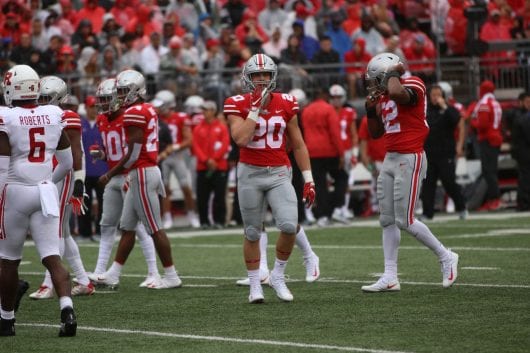
Ohio State then-sophomore linebacker Pete Werner (20) takes to the field in the first half of the game against Rutgers on Sept. 8. Ohio State won 52-3. Credit: Casey Cascaldo | Managing Editor for Multimedia
On Nov. 17, 2018, Anthony McFarland took an outside handoff and Ohio State cornerback Damon Arnette dipped inside, allowing the Maryland then-redshirt freshman running back to dash 81 yards untouched to the end zone.
It defined a primary issue with Ohio State’s defense in 2018, which allowed the most yards in school history. One player made a mistake, and a long touchdown run resulted. Opponents scored on run plays of 40 yards or more eight times this past season.
Against Cincinnati’s Michael Warren, who rushed for over 1,300 yards in 2018, the Buckeyes surrendered 15 yards on 10 carries. Four or five defenders — not just one — were around the ball carrier consistently. The Bearcats ran for 107 yards total, with 80 coming in the fourth quarter against backup players.
“When you run to the football and you play with great effort, the thing that you find out happens is your missed tackles slowly start going down, and your big plays really go down,” co-defensive coordinator Greg Mattison said.
Mattison is one of four defensive assistants hired by head coach Ryan Day to bring an identity of toughness and physicality to the defense, an identity Day referenced throughout the offseason.
By the time spring football rolled around, Mattison and his fellow staffers were working on a defense they said was “simplified,” one that would allow their athletes to fly to the ball.
Excluding the second half against Florida Atlantic and fourth quarter against Cincinnati — time frames occupied by second team defenders — the Ohio State defense allowed 23 rushing yards in five quarters of football.
“Everybody running to the football, no big plays allowed, kind of makes me love this defense,” junior linebacker Pete Werner said.
Werner has been a big part of both the 2018 and 2019 defenses, and said the success through two games is much better for morale.
“We get to third-and-5, we get ready to get off the field, and there’s a 25-yard gain,” Werner said. “Or if it’s first-and-10, they get a 25-yard gain, then they’re running down the field for a touchdown, you’re just like, ‘What’s going on?’”
Pursuit and stopping the run is a mentality that runs throughout the defense, however — not just with Werner and the front seven.
Junior safety Brendon White spoke to this team effort as the difference in mindset that sparked the change in Ohio State’s defense heading into 2019.
“We focused a lot in the offseason [on] pursuit to the ball, having all 11 hats at the ball,” White said.
White listed off the names of three of the new hires, pointing to their emphasis on the concept of pursuit that has served the Buckeyes well the past two games.
Mattison, who brought a different perspective than White, said he didn’t look back to what the team did last year. He only offered comment on what he’s seen since arriving in January, and in that regard, he said he is happy with the returns so far.
“When I walked in the very first day, I saw a group of guys that worked unbelievably hard every single day in that weightroom,” Mattison said. “Every day in the spring, and every meeting in camp, you saw a group of defensive guys that love each other, that wanted to become as good as they could be.”
With 48 seasons of experience, Mattison is the most tenured coach on staff.
“They have the opportunity to be as good as they want to be, and I mean that sincerely,” Mattison said.


